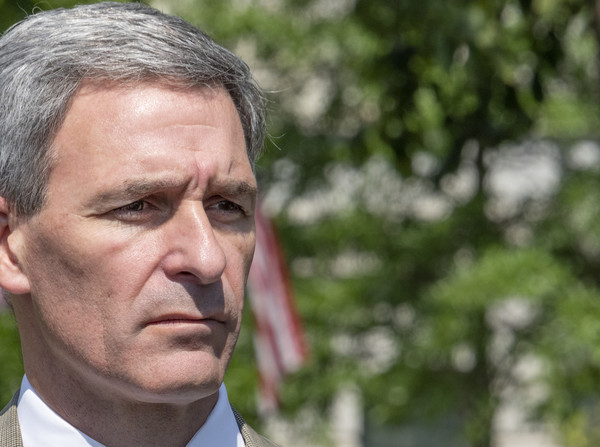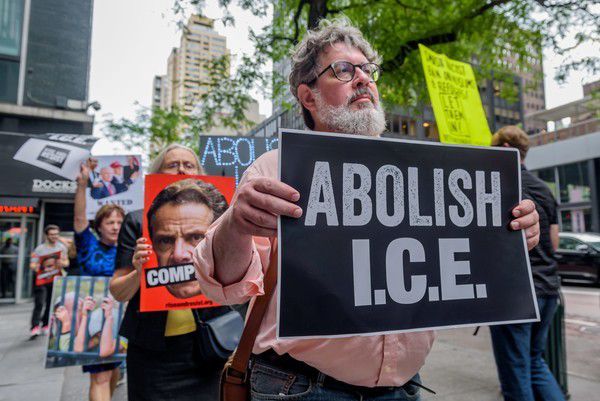U.S. immigration and border security policy headed toward a crossroads
During Trump’s first term in office, immigration and border policy have become hot-button issues in the U.S. The aggressive enforcement of border security has caused a backlash in the Democratic Party, which is now leaning toward decriminalizing illegal entry.

In a nutshell
- The upcoming U.S. elections could have a worldwide impact on migration policy
- The gap between the views of the political parties has significantly widened since 2016
- If President Trump is reelected but does not control both houses of Congress, he may seek to cut a deal
How American migration policy evolves over the next few years could have a worldwide impact, affecting not just the United States and Western Hemisphere but international migration policies and practices. Most polls identify immigration and border security as a top-tier issue among voters. The policies of the two major U.S. political parties appear to be on diverging paths. The election might deliver a mandate to either side. Nevertheless, the national elections are likely to have a dramatic impact on future policies.
The U.S. is on course to see one million people enter the country illegally in 2019. Since about one million people legally migrate to America each year, illegal entry and overstaying visas could account for about 50 percent of migration to the U.S. Illegal migration is also shifting. Rather than coming primarily from Mexico, a greater portion of illegal migration is coming from Central America and Asia, as well as from Africa. The shift in the composition of the illegal migrant population brings additional challenges. If this trend continues, it could have a significant impact on the American economy, demographics, civil society and politics.
Reform and discord
The U.S. has struggled with achieving a consensus on immigration and border security reform for decades. The last major immigration reform legislation passed under President Bill Clinton (1993-2001) in 1996. The terrorist attacks on New York and Washington, D.C. on September 11, 2001 renewed interest in reform legislation because of concerns over border security. President George W. Bush (2001-2009) attempted reform by modeling the Immigration Reform and Control Act of 1986 passed under President Ronald Reagan (1981-1989). This legislation offered amnesty to individuals unlawfully present in exchange for additional border security, tighter immigration enforcement and an expansion of temporary worker programs. President Bush’s proposed bill failed to pass in the U.S. Congress, as did two subsequent bills following the same approach under President Barack Obama (2009-2017).
When Donald Trump ran for president in 2016, he did so with an agenda of immigration enforcement. He most notably announced that a wall would be built between the U.S. and Mexico. Over the course of his presidency, few issues have been more polarizing than the feud between the president and his political opposition over immigration and border security policy. Indeed, matters that had previously been accepted with bipartisan support, including funding fencing and other infrastructure on the border, became hot-button political issues, culminating with a 34-day government shutdown between December 2018 and January 2019 over the inability to compromise on funding border security.
Few issues have been more polarizing than the feud between the president and his political opposition over immigration.
Subsequently, the gap between the views of the political parties only widened. The agenda of candidates seeking to head the Democratic presidential ticket in 2020 include measures such as decriminalizing illegal entry into the United States and providing free health care for illegal immigrants. Prominent voices in the Democratic camp have pressed for even more radical proposals including abolishing the law enforcement agency responsible for detaining and deporting illegal aliens. Additionally, many have adopted the cause of illegal aliens as a social justice campaign. So-called “sanctuary” states and communities refuse to cooperate with federal authorities in enforcing immigration laws. Other jurisdictions have made it easier for illegal aliens to get driving permits, housing, legal assistance and college scholarships.
By contrast, the Trump administration has doubled down on enforcement measures without bipartisan cooperation in Congress. The administration diverted funds from the Department of Defense to fund the construction of a wall on the Mexican border. President Trump also attempted to discontinue the Deferred Action for Childhood Arrivals (DACA) program, which allowed individuals brought to the country illegally as children to receive a renewable two-year period of deferred deportation. More recently, the administration tightened workplace enforcement of immigration, introduced measures for stricter compliance of public-charge requirements for legal immigration; broadened its authority to detain families until their final immigration status was determined; and sought to restrict meritless asylum claims. Virtually all these measures were immediately challenged in federal courts.
Nevertheless, the administration continues to pursue aggressive policies, partly in the hope of deterring illegal immigration, but also to highlight the divide between the president and his political opponents, whom he accuses of embracing open borders.
Forceful administration
In addition to implementing more aggressive policies, the administration has looked to make high-profile appointments of immigration hardliners in the Department of Homeland Security, the federal agency principally responsible for immigration and border enforcement – for example, appointing Mark Morgan as acting commissioner of Customs and Border Protection and Ken Cuccinelli as acting director of Citizenship and Immigration Services. In addition, Mr. Trump is intent on appointing former Homeland Security official Thomas Homan as his “border czar.” All three are close to the president and zealous advocates for immigration and border enforcement.
Furthermore, the administration has pressured Mexico, Central America and other countries to attempt to stem the flow of illegal immigration to the U.S. and reduce visa overstays – in addition to eschewing participation in the UN-sponsored Global Compact for Migration.

While the administration has intermittently floated the idea of working with Congress on border and immigration issues, there is no practical likelihood to this scenario. Both sides seem eager to use immigration as a defining wedge issue in the national campaign.
Nevertheless, the administration has prepared two draft pieces of federal legislation. One covers border security and immigration enforcement and addresses the many loopholes in current laws that would allow for stricter enforcement. The second piece of legislation would be a substantive overhaul of laws governing legal migration. Key elements of the draft reform include increased reliance on a merit-based system favoring younger, higher-skilled and educated migrants. In addition, the law would end the visa diversification lottery. Mr. Trump’s legislation would not reduce lawful immigration. Indeed, he has suggested that once the system is “fixed,” lawful immigration could well increase.
Scenarios
It is expected that the administration will seek congressional sponsors to introduce legislation during the current term, but it is extremely unlikely that such legislation would pass the House of Representatives, which is controlled by the opposition party. Nevertheless, the administration might try to introduce the bills to gain attention and highlight the president’s proposals prior to the election.
Progress for immigration reform will very likely hinge on the outcome of the 2020 national elections. If Mr. Trump is returned to office and Republicans gain control of both houses of Congress, then some version of the president’s draft bills will likely become law. President Trump’s Supreme Court appointments – which will consolidate his control over the nation’s highest judicial body – will certainly allow the administration to prevail over efforts to block these policies in the courts.
On the other hand, if a Democratic candidate becomes president and controls one or both chambers of Congress, then they will almost certainly introduce, and likely pass, a compromise bill that includes a broad immigration amnesty and watered-down immigration and border enforcement. A Democratic administration would seek to sign the United Nations Migration and Refugee Pacts, though the likelihood of these treaties being ratified by the Senate is virtually nil. The future of legal immigration reform would be highly problematic as there is no consensus within the party on what such reforms ought to look like.
If Mr. Trump is reelected but lacks control over both houses of Congress, then the fate of any legislative reform effort is uncertain. Democrats will most certainly insist on some form of amnesty, at the very least formalizing the DACA program. Republican views on amnesty are decidedly mixed. Most conservatives adamantly oppose amnesty. On the other hand, some, including conservatives and libertarians, have different views. Moving legislation on immigration and border enforcement would be extremely difficult, but not impossible. Mr. Trump has expressed a willingness to compromise on DACA and other issues in the past.
It is unclear whether the administration will attempt to press forward and cut a deal. Almost assuredly, President Trump would seek to move legislation on legal immigration reform, regardless of the composition of the Congress. There is, however, no consensus among Republicans over whether the overall number of immigrants should increase, decrease or remain the same.
As for the American electorate, three issues appear to dominate. First, Americans are concerned about the fiscal cost of illegal immigration and its burden on U.S. taxpayers. Secondly, they worry about fairness – that the system is not equitable, rational, humane or just. Thirdly, there are concerns about public safety, ranging from issues of human trafficking and exploitation to transnational gangs, crime, narcotrafficking and terrorists. The American electorate seems to favor President Trump’s hard-line approach, though much of the public media and activist groups are strongly anti-Trump, particularly on the immigration issue.
The most likely scenario is that President Trump will be reelected but that Republicans will not capture the House. In that event, the future of immigration reform could prove dynamic and be determined by perceptions of how the issue played out in the run-up to the elections. If Mr. Trump’s win is decisive and Republicans are focused on immigration, then the administration might press for a more muscular legislative agenda. Much will depend on the future leadership in a Democratic-controlled House and which factions within the party would ascend.
That said, regardless of the success of the legislative agenda, immigration is likely to remain a hot-button political issue for the foreseeable future. On the American left, illegal immigration has been embraced as a social justice issue and won’t be deterred by electoral setbacks. On the other hand, the American right will press Mr. Trump to follow through on his promises. If his reforms are successful and the economy and employment remain strong, then it is likely that in the years ahead immigration will stop being a controversial issue – even if the flow of immigration does not diminish or actually increases.







